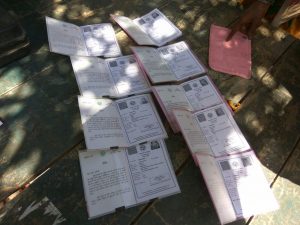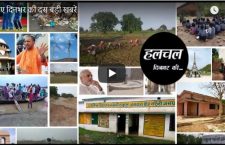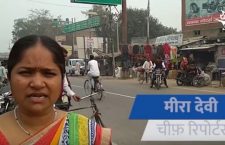Miles away from fancy investors’ summits and expressways, a state’s most basic concern remains as unaddressed as ever.
 “See, I first went to get my ration quota online in 2015, it was sometime in May. I was told I would get my card by July. Then, I was told it was cancelled in 2016. I was asked to apply for it afresh in May, since systems were being transitioned, so I did. Nothing happened through the rest of the year – either servers were not working, or there was something else off.” Neelam, from Banda town’s Bijli Kheda colony in Bundelkhand, provides the in-a-nutshell view of how her last year panned out, navigating through the jungle of red tape that surrounds the making of a ration card. “Ab 2018 aa gaya hai, hum phir aa gaye hain. (And now it’s 2018, and I’m back here again),” she concludes, in a narration of the worst kind of déjà vu experience.
“See, I first went to get my ration quota online in 2015, it was sometime in May. I was told I would get my card by July. Then, I was told it was cancelled in 2016. I was asked to apply for it afresh in May, since systems were being transitioned, so I did. Nothing happened through the rest of the year – either servers were not working, or there was something else off.” Neelam, from Banda town’s Bijli Kheda colony in Bundelkhand, provides the in-a-nutshell view of how her last year panned out, navigating through the jungle of red tape that surrounds the making of a ration card. “Ab 2018 aa gaya hai, hum phir aa gaye hain. (And now it’s 2018, and I’m back here again),” she concludes, in a narration of the worst kind of déjà vu experience.
Hers isn’t an ordinary need, though if you go by the numbers game, then hers is perhaps the most ordinary of all. In India, if you are part of the BPL population, or under the BPL – those oceans of faces termed, almost poetically, Antyodaya – then your ration needs are meant to be addressed urgently; the government provides it to you at subsidized rates, or free of cost. Your ration card – the singular access point to avail of the ration – is meant to be processed and issued at once, hassle-free. Indeed, as Antyodaya, your life is full of hassles any given day; it would help hugely if the path to your daal and chaawal and anaaj was a smoother one, relatively speaking.
But, enough theory and emotion. The picture on the ground tells an entirely different story. As Naniya of Piparhari village in Naraini block of Banda district shares, “I’ve spent days and days crying and pleading with the pradhan. He asks me, ‘Whose share of ration shall I take from to give to you, tell me?’ What can he do when my name isn’t on the list?” It has been an unchanging scenario, an ugly one through the decades and several changes of governments. But in 2017, when Uttar Pradesh finally voted for change and brought in the BJP, there had been hopes of shall we say, transformation? In April 2017, when the fortnight-old Chief Minister Yogi Adityanath, held his first Cabinet Meeting citing the myriad concerns that needed his immediate attention, it seemed as if the electoral mandate had been justified. Here was a sarkar that was displaying energy and agility – finally – a head of state who at 45, was proving himself to be the young, dynamic neta of everyone’s dreams. (And not the hateful hardliner of your nightmares spewing and aiding totalitarianism as a political bigwig).
The issue of ration, most notably its lack of availability to those who are, on paper, entitled to it, was among the priority items on Adityanath’s agenda in this meet. Even prior to the meet, the C.M. had issued an official statement on the problem while chairing a review meeting of officials from the Gorakhpur and Basti divisions thus: ‘The poor people must be issued ration cards, while stringent action be initiated against the food grain and ration mafia…’ And soon enough, decisions were taken and what’s more implemented. Among these were first off, the name-change game that the BJP seems particularly fond of – policies prefixed with ‘Samajvaad’ were changed into ‘Mukhyamantri yojnayein’. A campaign to declare invalid “fake” ration cards gained momentum, and the dated ones were held back from being distributed – seeing as they all had the ex-Chief Minister Akhilesh Yadav’s smiling face on them.
And there was more. In 2017, a team of experts from U.P. was sent to Jharkhand to study the Public Distribution System model followed there – an ironic move that, seeing how Jharkhand has been in the news for starvation deaths, where notices were allegedly put up requesting card bearers to contact the local PDS dealer before deciding to commit suicide. The U.P. system underwent an overhaul of sorts shortly after such that it could all follow-through in the virtual world – the application process went online, as did routine updates, and Aadhaar ID’s were linked to PDS. #DigitalIndia.
Of course, the obvious lacks apparent in a system that relies so heavily on biometrics – rural Bundelkhand often has last-mile connectivity issues, to say the least, with internet facilities being iffy and working minimally, in the best of situations – were not addressed. “Hamaara angootha nahi mil raha (They can’t seem to match my thumbprint)”, says Janki from Kevtara village, Banda, not a cryptic statement, especially when it’s juxtaposed against what Rajeev Tiwari, the district poorti adhikari, tells us, “The problems we’re facing are low-speed internet, machines that break down, Aadhaar linkages…” The situation is crippling in many ways – even when the system works, there are random glitches that end up wreaking havoc on lives. Take the case of Pushpa for instance, another Bijli Kheda mohalla local, who’s been trying to have the per-unit error rectified for almost a year now. She’s entitled to 7 units, she says, and has been surviving on just one, “That’s 5 kilos. Who all am I supposed to feed, with that?”
In a state that 16.5 % of the country’s population calls home, which is infamous for its dysfunctional and/or broken systems, it is almost a joke that the statistics that currently seem to matter the most to the Chief Minister is that very questionable ‘ease of doing’ numbers game. Uttar Pradesh, he said, glowing with pride, to the interviewee in a recent TV interview for ET ahead of the much-touted U.P. Investors Summit in Lucknow, has moved up on that list from 17 to 7 – “a jump of 10 spots”, he emphasized, well-versed in the power of rhetoric that relies on repetition.
But there’s other data too, which does not find iteration often enough. Our profiled ration report reviews the situation across two districts of Bundelkhand, wherein official statistics for kachcha housing is as follows: Banda – 44.23 %, Mahoba – 62.22 %. Doing the Math for the number of people living in these homes – all of whom are presumably being turned away from ration shops and galla centres – is perhaps more the need of the hour, if we’re only talking numbers.
As Manish Dwivedi, of Ramnagar colony in Mahoba town, Mahoba district complains, “It’s been a year now, chakkar laga raha hoon. I’ve come here five times, I’ve filled the same form five times. Ho jayega, ho jayega (it’ll happen), is what they keep saying. But it just never happens.”
All the expressways and defence corridors of the world – meant to uplift the poorly developed Bundelkhand region – cannot replace this most pressing issue. Because, first and foremost – you gotta eat.
– Pooja Pande

